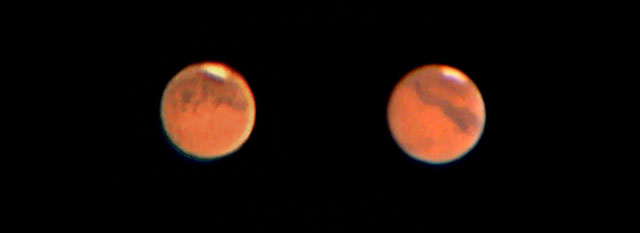
Mars

Copyright 2003 Hap Griffin
The Red Planet Mars near it's close approach in August 2003. These two images were taken roughly five hours apart and show the rotation of the planet, moving new geographical features into view. Mars's day is similar to that of Earth, a little over 24 hours. So during the five hours between these photos, the planet rotated through nearly a quarter turn. The South polar ice cap is conspicuous at the top of the planet (I chose to display in this orientation...south up...simply for esthetics).
In the left photograph the large dark area on the left is Solis Lacus, an area of relatively high moisture content. The Mars Observer craft has observed areas of dense fog and frost here. In the right photo, the long dark area consists of Mare Sirenum (the smaller portion) and Mare Cimmerium (the larger portion extending down and to the right). The Viking 2 landing site is near the lower portion of this photo. If you have your monitor adjusted properly, you can see a very faint darker region about one-third of the way between the north pole (opposite the ice cap) and the equator. A craft from Planet Earth stands watch here over a lonely and cold desert landscape.
The 2003 opposition brings Mars to its closest approach to Earth in recorded history...34.6 million miles. While the orbits of Earth and Mars bring them relatively close together approximately every two years, the 2003 opposition is special because the eccentricities of their elliptical orbits and their slightly different orbital planes come together just right. The apparent diameter of Mars during this time is approximately that of Jupiter, around 25 arc-seconds, making it very accessible in amateur telescopes. It's closeness also is given away by the fact that it outshines all other planets except Venus during this period.
For more information about Mars, see http://www.seds.org/billa/tnp/mars.html.
Date/Location:
August 15/16, 2003 Griffin/Hunter
Observatory Bethune, SC
Instrument: Meade 10" LX-200 with Logitec QuickCam
Pro 4000
Focal Ratio: f6.3 with additional 2X Barlow (approximately
f12.6)
Guiding: None
Conditions: Summer haze
Weather: 70 F, Still wind
Film: n/a
Exposure: 40 frames at 1/10 second each
Filters: None
Processing: Registered, stacked and wavelet processed in
Registax, finished in Photoshop 6